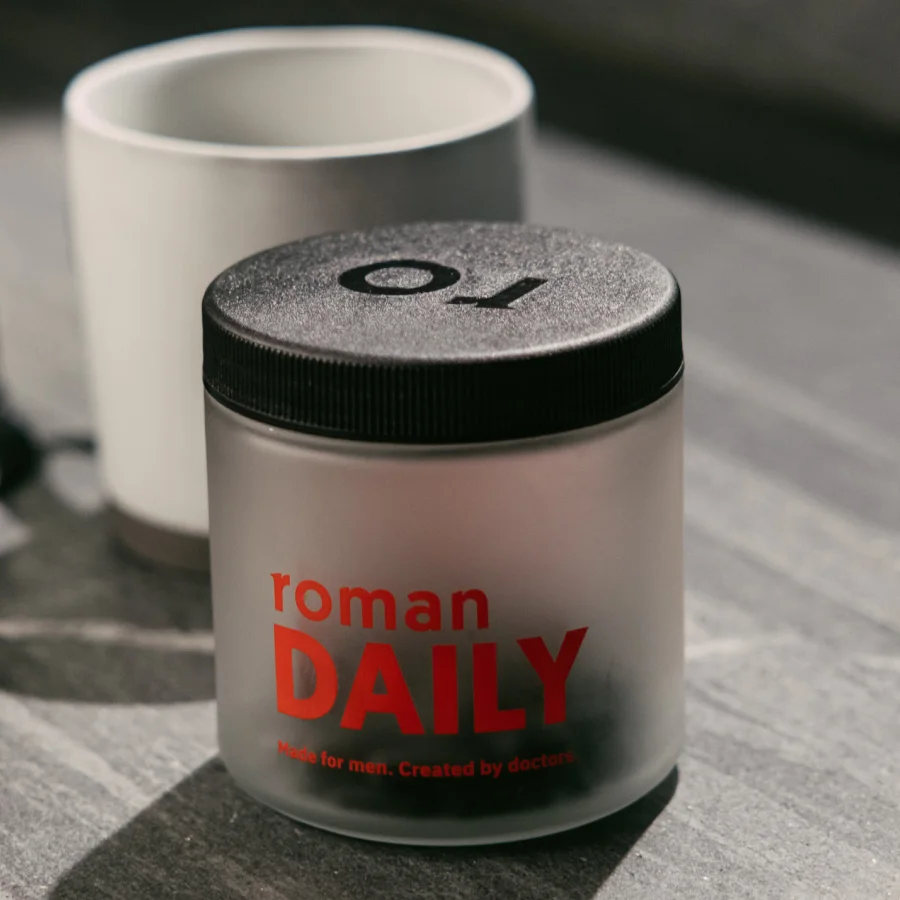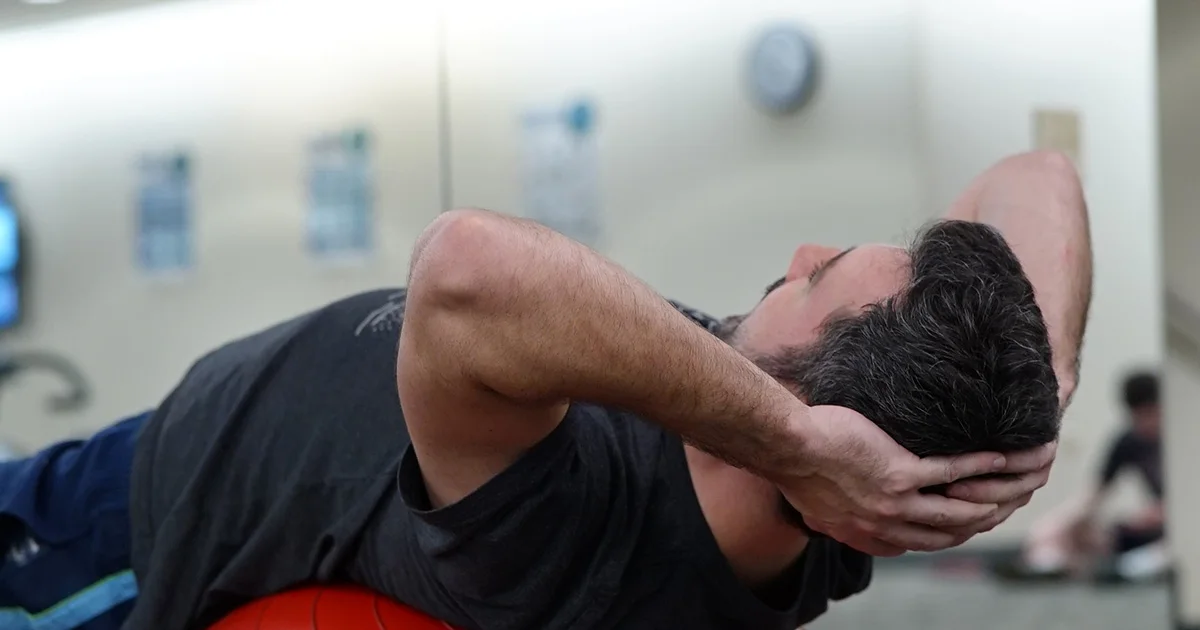Here's what we'll cover
Here's what we'll cover
Maybe you’ve been feeling run-down lately, or are struggling to finish that last set at the gym. This could all be regular wear and tear, but it could also be a sign of low testosterone.
There are a number of treatments for low testosterone, and one you may have heard of is an extra dose of vitamin D. But can taking vitamin D supplements boost your testosterone?
While some people with both vitamin D and testosterone deficiency may see a boost in testosterone when taking vitamin D supplements, most people will likely not. Here’s what you need to know about testosterone, vitamin D, and what to do if you feel like you may have low testosterone, or a vitamin D deficiency.
What’s the connection between vitamin D and testosterone?
Vitamin D is an essential nutrient that promotes bone health and helps protect against osteoporosis, a condition where bones are weak and brittle. It also supports healthy nerve and muscle function (Sizar, 2020).
What exactly does this have to do with testosterone? Low testosterone can have signs and symptoms that are similar to a vitamin D deficiency: for example, the erectile dysfunction and decreased sex drive seen in testosterone deficiency can also be caused by depressed mood from low vitamin D. Other parallel symptoms between low testosterone and vitamin D deficiency include (Rivas, 2014; Holick, 2011):
Weakness
Fatigue
Decreased bone and muscle strength
For low testosterone or vitamin D levels, it’s best to first confirm low levels through a blood test and then, for most people, address improving them individually, which we’ll delve into further down.
Can taking vitamin D supplements raise my testosterone levels?
The link between vitamin D and testosterone isn’t well understood, however, studies have shown that taking vitamin D may affect testosterone for some people.
One study looked at middle-aged men who had both low vitamin D and low testosterone. After taking vitamin D supplementation, both their vitamin D and testosterone levels improved (Pilz, 2011). However, research also found that healthy, middle-aged men with normal testosterone levels had no changes after taking vitamin D supplements (Lerchbaum, 2017). Another study found that healthy men aged 18 to 35 had no changes in testosterone after supplementing with vitamin D (Wrzosek, 2020).
In a study looking at male and female athletes, taking vitamin D had no effect on testosterone levels, even for those with low vitamin D (Krzywański, 2020). As you can see from the conflicting data, there isn’t currently enough evidence to support using vitamin D to increase testosterone levels.
I think my testosterone levels are low, what should I do?
If you suspect you may have low testosterone, the first step is getting your levels checked by a healthcare provider. Along with questions about symptoms and a physical exam, a healthcare provider may perform a blood test to evaluate the levels of testosterone in your blood as well as the levels of other substances that can affect your testosterone levels like FSH (follicle-stimulating hormone), LH (luteinizing hormone) and more (Rivas, 2014).
What causes low testosterone?
Testosterone is the major sex hormone in men, but it also supports women’s health. This hormone is vital for males for muscle size and strength, bone strength, sex drive, and sperm production. For females, testosterone is believed to support healthy ovaries, bone strength, and libido as well (Davis, 2015).
Testosterone levels naturally drop as men age, but some drop lower than others, and this can cause a condition called hypogonadism. An estimated 39% of men aged 45 or older in the US have low testosterone (Rivas, 2014).
Certain conditions can also contribute to low testosterone, like liver disease, cancer treatments, and some brain tumors (Sinclair, 2015; Rivas, 2014).
What treatments are there for low testosterone?
The treatments for low testosterone include testosterone replacement therapy (TRT) and medications that can boost your body’s natural testosterone production (like HCG, clomiphene, and anastrozole). Testosterone therapy comes in many forms (like gels, patches, and injections), and gives your body the extra testosterone it can’t produce on its own (Rivas, 2014). It’s not without side effects, however.
If you have low testosterone, a healthcare provider may discuss testosterone therapy, or suggest waiting a few months and then getting your levels re-tested.
Is testosterone replacement therapy safe?
There is still a lot of controversy surrounding testosterone therapy, despite now debunked beliefs about side effects of this treatment. Unlike previously thought,testosterone therapy does not increase the risk of prostate cancer or cardiovascular diseases, like heart attack and stroke (Morgentaler, 2016).
For most people with low testosterone levels, testosterone therapy is safe and effective. However, there are some potential side effects to be aware of, which include (Morgentaler, 2016):
Acne
Breast tenderness or enlargement
Increased red blood cell count
Edema or swelling in the extremities
Testicular shrinkage
Infertility or decreased sperm production
It’s also a good idea to discuss your plans for fertility with a healthcare provider before starting any testosterone replacement therapy. For men interested in preserving fertility, alternative treatments can be offered for hypogonadism. While not FDA-approved, these alternative treatments can be prescribed “off-label” by a healthcare provider to treat low testosterone and have been shown in studies to be effective at increasing testosterone levels (Thirumalai, 2017).
HCG is a treatment for hypogonadism that doesn’t negatively affect fertility. HCG stands for human chorionic gonadotropin and is basically a hormone that boosts your body’s natural production of testosterone. Treatment with hCG is less likely to cause side effects compared to TRT, but does involve more frequent injections and may cause testicular enlargement (Thirumalai, 2017).
Anastrozole is another treatment for low testosterone. It belongs to a class of medications called aromatase-inhibitors which just means it works by blocking testosterone from being converted to estrogen, a normal bodily process. Anastrozole has been shown to increase testosterone levels with reported improvements in muscle strength and sexual desire; one side effect is a possible decreased bone density (Thirumalai, 2017).
Clomiphene is a medication that works by letting your brain produce more of a hormone that tells your body to make more testosterone. It is cost-effective and has been shown to increase testosterone. In addition, clomiphene is associated with few side effects; in one study, men actually had less breast tenderness and fewer skin problems after taking clomiphene (Guo, 2019).
What is the treatment for low vitamin D?
If you are having signs and symptoms that could be related to low testosterone and find that your testosterone levels are normal, those symptoms of fatigue, depressed mood, or muscle weakness may be caused by low vitamin D. The only way to know for sure is to get your vitamin D levels checked.
Vitamin D deficiency is a problem all on its own. An estimated 41.6% of people in the US have vitamin D deficiency, with increased risk for people with darker skin pigmentation or reduced sun exposure, which includes people living farther away from the equator, nursing home residents, and healthcare workers (Forrest, 2011). Other risk factors for vitamin D deficiency include kidney disease, liver disease, inflammatory bowel disease, and gastric bypass surgery (Sizar, 2020).
The best way to treat low vitamin D by increasing your dietary intake. There are two kinds of vitamin D found in food products: D2 and D3. D2 is from plant products; D3 is commonly found in fatty fish and egg yolks. Vitamin D3 is believed to be more effective than D2 at boosting vitamin D levels (Tripkovic, 2017).
The recommended initial dose to treat vitamin D deficiency is 6000 IU (units) daily or 50,000 IU weekly for eight weeks, followed by 1000 IU or 2000 IU daily for maintenance (Holick, 2011). You can meet this intake requirement through diet or by taking a high-dose vitamin D3 supplement called cholecalciferol.
Diet
Here are some common foods and how much vitamin D3 they contain (ODS, 2020):
Cod liver oil: 1 tablespoon—1,360 IU (units)
Salmon (sockeye), cooked: 3 ounces—570 IU
Egg: 1 large, with yolk—44 IU
Tuna fish (light), canned in water, drained: 3 ounces—40 IU
Cheese, cheddar: 1 ounce—12 IU
Milk, 2% milkfat, vitamin D fortified: 1 cup—120 IU
Vitamin D3 (cholecalciferol)
Vitamin D3 is available as an over-the-counter supplement or prescription medication. Doses vary based on the manufacturer and include 400 IU, 800 IU, 1000 IU, and 5000 IU. Weekly formulations are also available, such as vitamin D2 50,000 IU. While rare, toxicity due to going over the recommended intake of vitamin D3 can occur. Common side effects of taking too much vitamin D include nausea, vomiting, and weakness (Sizar, 2020).
Currently, the relationship between testosterone and vitamin D is still being evaluated. While some research suggests that taking vitamin D may increase testosterone in some men with low levels of both, most other people did not see a similar benefit, including healthy young men and athletes of both sexes.
For low vitamin D or testosterone levels, the best way for most people to improve them is to take treatments targeted at each problem separately. For low vitamin D, that means getting more vitamin D from your diet, either from food products or supplements. For low testosterone, testosterone replacement therapy is effective, as well as other treatments like clomiphene and hCG, which preserve fertility.
DISCLAIMER
If you have any medical questions or concerns, please talk to your healthcare provider. The articles on Health Guide are underpinned by peer-reviewed research and information drawn from medical societies and governmental agencies. However, they are not a substitute for professional medical advice, diagnosis, or treatment.
Davis, S. R., & Wahlin-Jacobsen, S. (2015). Testosterone in women--the clinical significance. The Lancet. Diabetes & Endocrinology, 3 (12), 980–992. doi: 10.1016/S2213-8587(15)00284-3. Retrieved from https://pubmed.ncbi.nlm.nih.gov/26358173/
Forrest, K. Y., & Stuhldreher, W. L. (2011). Prevalence and correlates of vitamin D deficiency in US adults. Nutrition Research, 31 (1), 48–54. doi: 10.1016/j.nutres.2010.12.001. Retrieved from https://pubmed.ncbi.nlm.nih.gov/21310306/
Guo, D. P., Zlatev, D. V., Li, S., Baker, L. C., & Eisenberg, M. L. (2020). Demographics, Usage Patterns, and Safety of Male Users of Clomiphene in the United States. The World Journal of Men's Health, 38 (2), 220–225. doi: 10.5534/wjmh.190028. Retrieved from https://pubmed.ncbi.nlm.nih.gov/31385473/
Holick MF, Binkley NC, Bischoff-Ferrari HA, Gordon CM, Hanley DA, Heaney RP, Murad MH, Weaver CM., Endocrine Society. (2011). Evaluation, treatment, and prevention of vitamin D deficiency: an Endocrine Society clinical practice guideline. Journal of Clinical Endocrinology and Metabolism, 96 (7), 1911-30. doi: 10.1210/jc.2011-0385. Retrieved from https://pubmed.ncbi.nlm.nih.gov/21646368/
Krzywański, J., Pokrywka, A., Młyńczak, M., & Mikulski, T. (2020). Is vitamin D status reflected by testosterone concentration in elite athletes?. Biology of Sport, 37 (3), 229–237. doi: 10.5114/biolsport.2020.95633. Retrieved from https://pubmed.ncbi.nlm.nih.gov/32879544/
Lerchbaum, E., Pilz, S., Trummer, C., Schwetz, V., Pachernegg, O., Heijboer, A. C., & Obermayer-Pietsch, B. (2017). Vitamin D and Testosterone in Healthy Men: A Randomized Controlled Trial. Journal of Clinical Endocrinology and Metabolism, 102 (11), 4292–4302. doi: 10.1210/jc.2017-01428. Retrieved from https://pubmed.ncbi.nlm.nih.gov/28938446/
Morgentaler, Abraham. (2016). Controversies and Advances With Testosterone Therapy: A 40-Year Perspective. Urology, 89 (27-32). doi: 10.1016/j.urology.2015.11.034. Retrieved from https://pubmed.ncbi.nlm.nih.gov/26683750/
Office of Dietary Supplements (ODS). (October, 2020). Vitamin D Fact Sheet for Health Professionals. NIH. Retrieved on February 16, 2021 from https://ods.od.nih.gov/factsheets/VitaminD-HealthProfessional/#en25
Pilz S, Frisch S, Koertke H, Kuhn J, Dreier J, Obermayer-Pietsch B, Wehr E, Zittermann A. (2011). Effect of vitamin D supplementation on testosterone levels in men. Hormone and Metabolic Research, 43 (3), 223–5. doi: 10.1055/s-0030-1269854. Retrieved from https://pubmed.ncbi.nlm.nih.gov/21154195/
Rivas, A. M., Mulkey, Z., Lado-Abeal, J., & Yarbrough, S. (2014). Diagnosing and managing low serum testosterone. Proceedings (Baylor University. Medical Center), 27 (4), 321–324. doi: 10.1080/08998280.2014.11929145. Retrieved from https://www.ncbi.nlm.nih.gov/pmc/articles/PMC4255853/
Sinclair, M., Grossmann, M., Gow, P. J., & Angus, P. W. (2015). Testosterone in men with advanced liver disease: abnormalities and implications. Journal of Gastroenterology and Hepatology, 30 (2), 244–251. doi: 10.1111/jgh.12695. Retrieved from https://pubmed.ncbi.nlm.nih.gov/25087838/
Sizar O, Khare S, Goyal A, et al. (2020). Vitamin D Deficiency. StatPearls. Retrieved on Feb 1, 2021 from https://www.ncbi.nlm.nih.gov/books/NBK532266/
Thirumalai, A., Berkseth, K. E., & Amory, J. K. (2017). Treatment of Hypogonadism: Current and Future Therapies. F1000Research, 6,
doi: 10.12688/f1000research.10102.1. Retrieved from https://www.ncbi.nlm.nih.gov/pmc/articles/PMC5265703/
Tripkovic, L., Wilson, L. R., Hart, K., Johnsen, S., de Lusignan, S., Smith, C. P., Bucca, G., Penson, S., Chope, G., Elliott, R., Hyppönen, E., Berry, J. L., & Lanham-New, S. A. (2017). Daily supplementation with 15 μg vitamin D2 compared with vitamin D3 to increase wintertime 25-hydroxyvitamin D status in healthy South Asian and white European women: a 12-wk randomized, placebo-controlled food-fortification trial. The American Journal of Clinical Nutrition, 106 (2), 481–490. doi: 10.3945/ajcn.116.138693. Retrieved from https://pubmed.ncbi.nlm.nih.gov/28679555/
Wrzosek, M., Woźniak, J., & Włodarek, D. (2020). The Combination of a Diversified Intake of Carbohydrates and Fats and Supplementation of Vitamin D in a Diet Does Not Affect the Levels of Hormones (Testosterone, Estradiol, and Cortisol) in Men Practicing Strength Training for the Duration of 12 Weeks. International Journal of Environmental Research and Public Health, 17 (21), 8057. doi: 10.3390/ijerph17218057. Retrieved from https://pubmed.ncbi.nlm.nih.gov/33139636J










